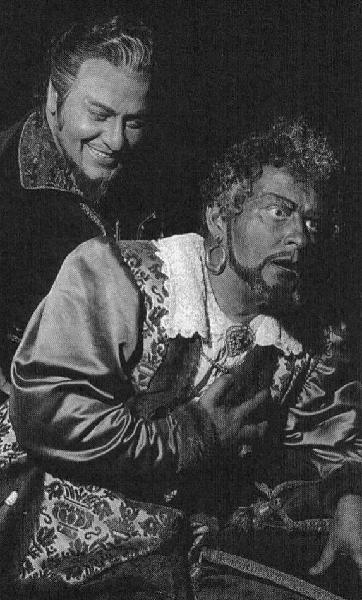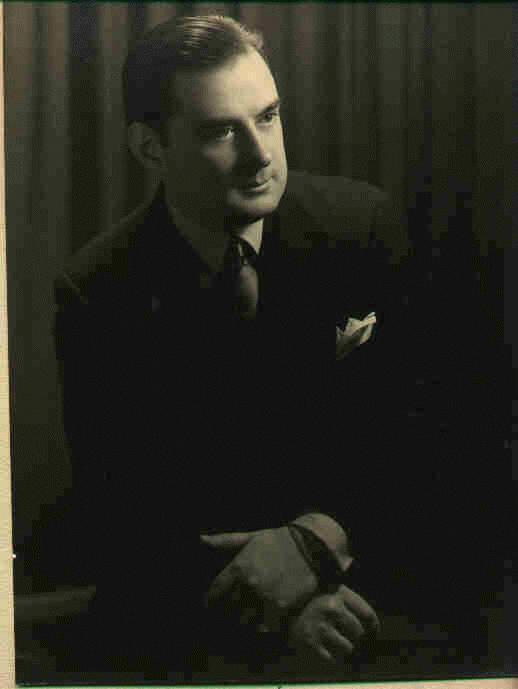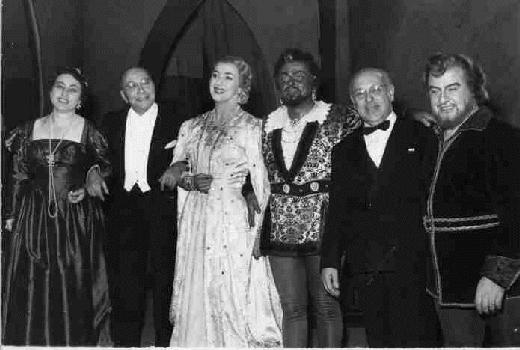Carlos Maria Guichandut
with Giuseppe Taddei
| Carlos Maria Guichandut sings Cavalleria rusticana: Viva il vino |
In RA format
Guichandut was born in Buenos Aires (Argentina) on November 4th, 1914, and studied with M° Bonta.
Guichandut made his debut at the Anfiteatro de la Rural, during the summer season of the Teatro Colón de Buenos Aires in the opera La
novia del hereje by Pascual de Rogatis.
In those years, Guichandut was selected by the famous mezzosoprano Gabriella Besanzoni for several seasons in Rio de Janeiro (Brazil), where
Guichandut was able to perform the most important roles for baritone.
At his return to Buenos Aires, Guichandut sang from 1941 to 1943 with the zarzuela company headed by the Spanish soprano Fidela Campiña
(who became his wife), at the Teatro Avenida and Teatro San Martin in Buenos Aires, and on a large tour across South America.
In 1944, Guichandut sang at the Teatro Marconi in Buenos Aires: Rigoletto, Marcello (Bohème), Germont (Traviata), Figaro
(Barbiere di Siviglia), Tonio and Silvio in different performances of Pagliacci, Conte di Luna in Il trovatore and Enrico in
Lucia di Lammermoor.
Guichandut made his debut at the Teatro Colón on May 25th, 1945 in Rigoletto, engaged by M° Hector Panizza, and his partners
were Hilde Reggiani and Bruno Landi. Others roles in the same season were: Lucas (Aurora by Panizza), Shaklovityj in Khovanshchina,
Figaro (Barbiere), Germont and Tonio. In 1945, Guichandut also made his debut at the Liceu in Barcelona, where he sang Tonio, Figaro,
Renato (Ballo in maschera), Rigoletto and Scarpia.
Other appearances include:
1946 Teatro Colón: Tosca and Rigoletto
1947 Teatro Colón: Figaro, Rigoletto, Gérard (from Andrea Chénier), with Maria Caniglia and Beniamino Gigli and La
forza del destino with Gigli. The great tenor introduced him in Italy where Guichandut sang Bizet's Pêcheurs de perles with
Giuseppe Di Stefano.
In 1948 at Teatro Colón, Guichandut appeared in: La traviata with Gigli and Delia Rigal, Il trovatore with Gigli as Manrico,
Maria Caniglia and Fedora Barbieri, M° Panizza conducting, and Borodin's Knjaz Igor. The same year, Guichandut made his Scala debut
with Un ballo in maschera, His partners were Elisabetta Barbato and Gianni Poggi.
In 1949 at Teatro Colón, Guichandut sang La forza del destino with Mario Del Monaco and Delia Rigal, La traviata and
Gounod's Faust.
In 1950 at the Teatro Colón, Guichandut appeared in: La traviata, Otello (as Iago, in Mario Del Monaco's debut in the title
role) and again Forza with the same cast as the previous year.
Then Guichandut moved to Europe, where he established himself with his wife. Between 1951 and 1952, due to his easy high notes and his strong
voice, Guichandut decided to change his vocal range, and with Fidela Campiña's help, Guichandut became a dramatic tenor. His first role in
the new range was Siegmund in Wagner's Walküre at the Teatro Petruzzelli in Bari.
In 1953, Guichandut sang with Maria Callas in her first Medea, at the Maggio Musicale Fiorentino with M° Gui conducting.
In 1955, Guichandut returned to the Teatro Colón where he sang Otello (this time the title role, with Giuseppe Taddei as Iago), Andrea
Chénier and Turiddu.
In 1956 at La Scala, Guichandut appeared in Carmen. In 1957, Guichandut sang at the Paris Opéra (Otello with Régine
Crespin), Radamès at Covent Garden, and Otello with Karajan at the Wiener Staatsoper for a total run of 22 performances up to 1963.
In 1966 after a successful career in Europe and 297 Otello performances and many other roles, singing alongside great opera stars or
conductors like Renata Tebaldi, Birgit Nilsson (in Turandot), Leonie Rysanek, Leontyne Price, Anna Moffo, Georg Solti, Tullio Serafin,
among many others, Guichandut returned to live in Buenos Aires and dedicated himself to teaching voice, still in possession of perfect vocal
powers. Among his pupils was Luis Lima, the great Argentinean international tenor. His last performance was at the Teatro Colón in 1974 in
by Panizza. After his wife's death in 1983, Guichandut frequently fell into depression; he died in Buenos Aires on September
27th, 1990.
Carlos Guichandut was one of the few opera singers, who after changing their vocal range from baritone to tenor could sing roles in both keys in
the same opera, for example:
Pagliacci: Tonio – Silvio – Canio
Andrea Chénier: Gérard – Chénier
Aida: Amonasro – Radamès
Otello: Iago – Otello
Cavalleria rusticana: Alfio – Turiddu
Comments by Esteban C. Guichandut
I am the nephew of Carlos Maria Guichandut.
Regarding his biography, I would to add the following.
In 1989, Guichandut was awarded a diploma by the Konex Foundation in Buenos Aires. It was the diploma of
merit in the discipline "Masculine singer" in the field of classical music.
He continued to teach young singers at the Teatro Colón in Buenos Aires, at the Superior Institute of Art.
Also during the first visit of Luciano Pavarotti to Buenos Aires, while Luciano was walking through the hallways of the
Teatro Colón, Carlos Guichandut showed up. Luciano Pavarotti recognized him and shouted "Esultate", the opening of Otello. He
greeted Carlos and told him that he was once in the choir of Otello when Carlos performed, and thought that he was one of the best Otellos
he had ever seen.
Discography
There are few commercial recordings of Carlos Maria Guichandut. In Italy, Guichandut recorded a few operatic arias as a baritone:
Hamlet (Thomas): Ô vin, dissipe la tristesse
Un ballo in maschera (Verdi): Eri tu
Otello (Verdi): Credo
La traviata (Verdi): Di Provenza
As a tenor, Guichandut recorded a complete Otello with Brogini, Taddei and Cleva for Cetra. There is Medea with Callas from the Maggio
Musicale, recorded live. And that's his entire official output.
However there are some historical recordings from the Teatro Colón, unfortunately not commercialized:
Complete Otello (1950), with the Mario Del Monaco in his Otello role debut, Guichandut as Iago, and Delia Rigal as Desdemona. A complete Bisanzio
by Panizza recorded in 1974. And there are highlights from: Andrea Chénier (as Chénier), Cavalleria rusticana (as Turiddu), Forza
del destino with Gigli, the same opera with Del Monaco, and Traviata (as Germont) with Delia Rigal and Rafael Lagares.
with Taddei, Curtis Verna and Bellezza in Otello
I wish to thank Daniele Godor for the picture with Taddei in Otello.
I wish to thank Roberto Falcone for providing the biographical and discographical information, the recording and the Taddei/Curtis
Verna/Bellezza picture.
|


